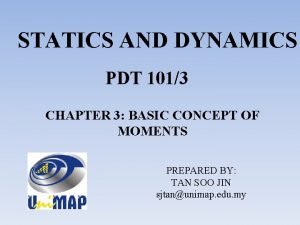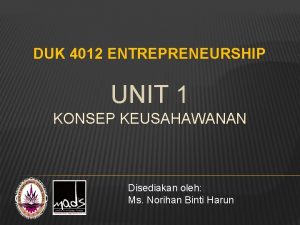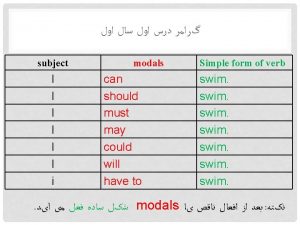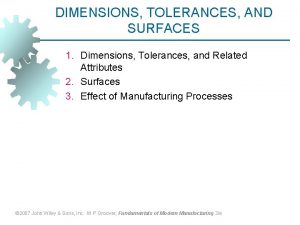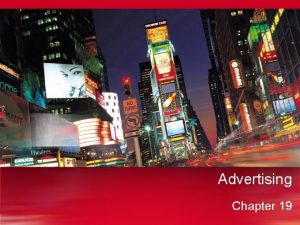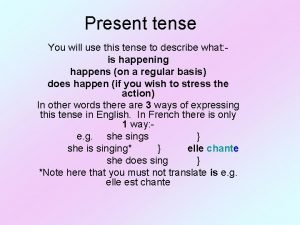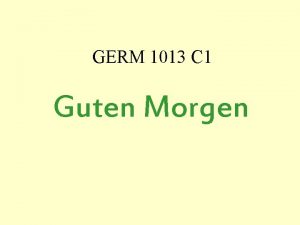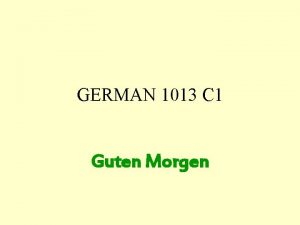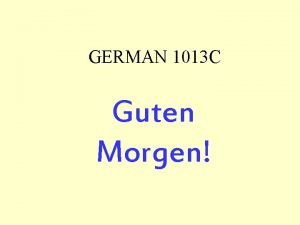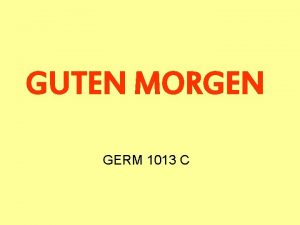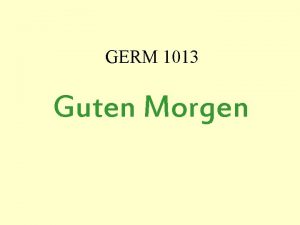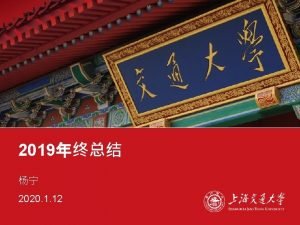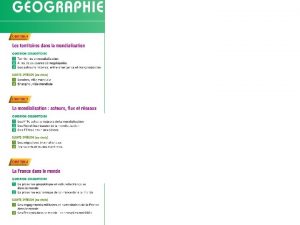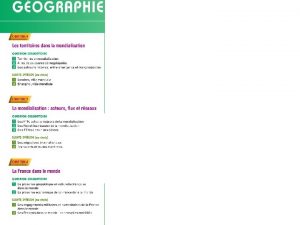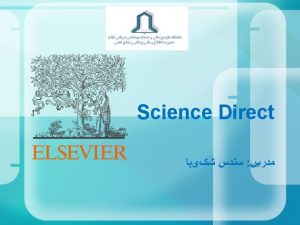1013 HOMEWORK 1013 homework Finish page 135136 in



























- Slides: 27

10/13 HOMEWORK 10/13 homework: Finish page 135136 in the blue workbook and on page 32 in your notebook take notes on Genetic drift and gene flow. I will check tomorrow.

10/13 Daily Catalyst Pg. 31 Mutations 1. In a population in HWE, 32% of the people have green hair (recessive trait) and 68% of people have purple hair (dominant trait). Over the next five years, how would you expect the percentage of hair color to change? 2. What three HWE conditions cannot be met? Why can they not be met? 3. What can you assume about analogous structures and their DNA?

10/13 Daily Catalyst Pg. 31 Mutations 1. In a population in HWE, 32% of the people have green hair (recessive trait) and 68% of people have purple hair (dominant trait). Over the next five years, how would you expect the percentage of hair color to change? The percentages will not change! HWE! 2. What three HWE conditions cannot be met? Why can they not be met? Mutations, Natural selection, and random mating 3. What can you assume about analogous structures and their DNA? These organisms do not share a percentage of DNA. They JUST live in the same environment

10/13 Daily Catalyst Pg. 31 Mutations Daily catalyst Class Business Homework review Mutation Notes

HW Review

10/13 Daily Objective Pg. 31 Mutations We will be able to connect evolutionary changes in populations over time to a change in the environment.

Recap When gene frequencies change, this is evolution occurring at the smallest scale. Key Point #1: A change in the gene pool is called microevolution.

Genetic Variation We have no problem picking out our friends and family in a crowd because of the variation in traits. Not all variation is heritable. Provide an example of this: Muscle mass and tattoos

Key Point #2: ONLY THE GENETIC COMPONENT OF VARIATION IS RELEVANT TO NATURAL SELECTION.

Darwin’s Observations • There is variation within a given species and the majority of this variation is inherited. This litter of kittens vary with respect to coat pattern and color. • Any variation may, to some degree, affect the ability of an organism to reproduce and contribute genes to the gene pool, thus affecting evolutionary success. • Species change over time. These changes are related to traits that are inherited or arise from an alteration of the genetic code. • Some inherited traits are beneficial and contribute to survival. • Whether a trait is beneficial or not is a function of the environment in which 10 it lives.

Adaptations and Fitness An adaptation is a genetically controlled trait that is favored by natural selection and gives the organism a reproductive advantage ensuring the trait is passed on to its descendants. This trait may also allow the individual to survive longer thus increasing the reproductive rate of that individual. 11

Adaptations and Fitness The antelope hare lives in the desert, and the snowshoe hare lives in the mountains. Explain how the differences in their traits enhance their ability to survive in their respective environments. Evolutionary success or fitness refers to the contribution of genes to the gene pool and NOT how long an organism lives. 12

The Effect of Environmental Change • Earth’s environment is NOT STATIC, but rather ever changing. • As a consequence, traits or adaptations that were favorable may become unfavorable. • The peppered moth, Biston betularia is native to England exists in two forms, one is dark and the other light with a “peppered” appearance. Birds are its main predator. • Prior to the industrial revolution, only 2% of the moths were dark. • The industrial revolution produced vast amounts of sulfur dioxide and soot from the burning of coal which altered the environment. • Fifty years later 95% of the moths were dark. • Propose an explanation! 13

Industrial Melanism England has since regulated the burning of coal and as a result, the trees are returning to their original state (A). Consequently, the coloring among the population of moths in Britain has shifted back so that the peppered moths are once again favored. 14

Evolution Defined Evolution is defined as a change in the inherited characteristics of biological populations over successive generations. Evolutionary processes give rise to diversity at every level of biological organization, from the molecular to the macroscopic. As a result diversity is prevalent among molecules such as DNA as well as individual organisms and species of organisms. 15

Microevolution is simply a change in gene frequency within a population. Evolution at this scale can be observed over short periods of time such as from one generation to the next. Example: The frequency of a gene for pesticide resistance in a population of crop pests increases. Such a genetic change might come about because: natural selection favored the gene the population received new immigrants carrying the gene (gene flow) nonresistant genes mutated into a resistant version of the gene or random genetic drift from one 16 generation to the next

Microevolution A gene is a sequence of DNA nucleotides that specify a particular trait. An allele is a different version of a gene For example: black coat color or white coat color B represents the allele for black coat color and b for white coat color. Key Point #3: Natural selection acts on individuals, but only populations evolve. 17

Remember last week when I told your DNA determines your inward and outward appearance? Genotype: genetic make up (gene for type O blood) Phenotype: expression of traits (eye color) Selection acts on phenotype because differential reproduction and survivorship depend on phenotype not genotype. Do you have what it takes to survive?

Sources of Genetic Variation How does variation in a population or gene pool arise? MUTATIONS! The wisteria pictured on the right has a mutation causing it to produce white flowers instead of purple flowers. 19

Types of Mutations Key Point #4: Only mutations occurring in gametes affect future generations. Gamete cell, what? ! SEX CELLS (sperm and egg) Obviously, mutations occurring in somatic cells do not affect future generations. Somatic cells, what? ! All the rest of your cells (bones and skin) 20 Mutations may cause a sheep to have a 5 th leg. But this is not evolution!

Mutations can occur at either the gene or chromosomal level.

Point/Substitution Mutations Key Point #5: One nucleotide is substituted for another. If this mutation does not affect the function of the protein, then this mutation is harmless. AKA silent mutations


Some mutations may add or delete nucleotides therefore affecting the protein that is coded for.

Frameshift Mutation Key Point #6: A frameshift mutation occurs as a result of either an insertion or deletion of a nucleotide. AKA insertion mutation AKA deletion mutation This changes the amino acid sequence of the protein from that point forward. This has a huge effect!

What are my chances? Mutation rates in eukaryotic cells average about one in every 100, 000 genes per generation.

What else can alter a population’s genetic composition? Genetic Drift: Bottleneck Effect Founder Effect: Gene Flow
 Bpme 1013
Bpme 1013 A force of 800n acts on a bracket as shown
A force of 800n acts on a bracket as shown Dasar kerajaan
Dasar kerajaan What did your partner do last weekend
What did your partner do last weekend Did you do your homework
Did you do your homework Apa 7 running head
Apa 7 running head Homework oh homework i hate you you stink
Homework oh homework i hate you you stink Literal language example
Literal language example Jack prelutsky homework oh homework
Jack prelutsky homework oh homework Homework oh homework poem
Homework oh homework poem Homework oh homework i hate you you stink
Homework oh homework i hate you you stink Alitteration definition
Alitteration definition Final sketch crime scene
Final sketch crime scene Finish the sentence icebreaker
Finish the sentence icebreaker Finishgrant.world
Finishgrant.world Fabric finish
Fabric finish Finish
Finish شکل سوم فعل think
شکل سوم فعل think Habit 2 bokstäver
Habit 2 bokstäver Surface finish tolerances for manufacturing
Surface finish tolerances for manufacturing Major and minor retainer
Major and minor retainer Finish these sentences
Finish these sentences Verb 3 repair
Verb 3 repair Lent finish
Lent finish Surface finish symbols
Surface finish symbols Finish the slogan quiz
Finish the slogan quiz Present tense of finish
Present tense of finish Opening letter formal
Opening letter formal

